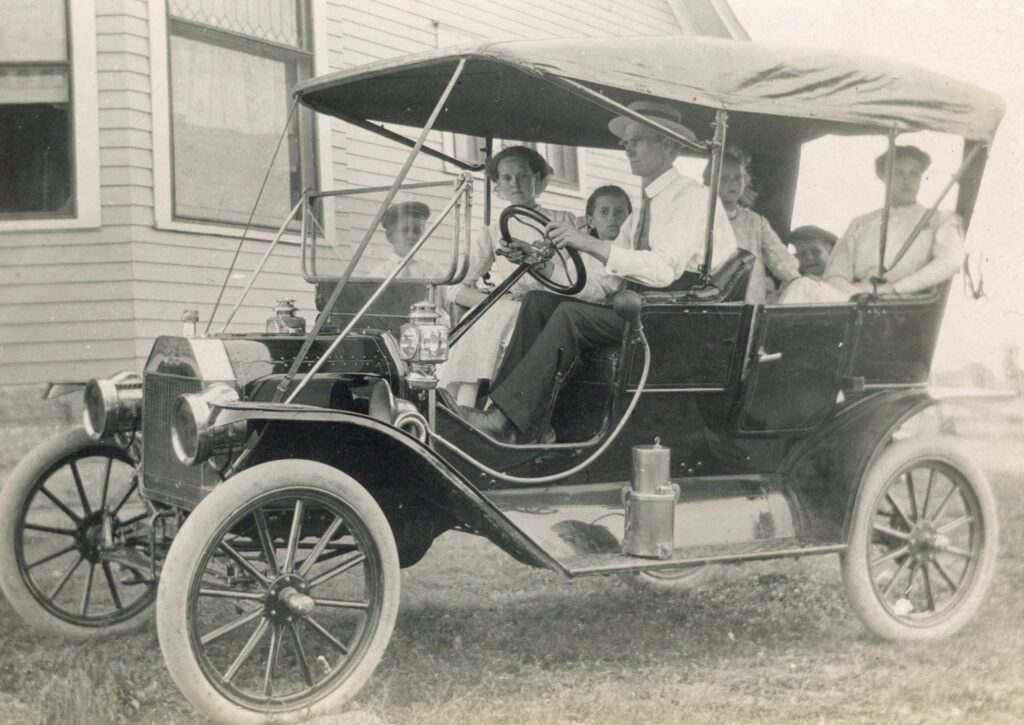Let’s take a look at an epic road trip that my grandparents (my dad’s parents) took as newlyweds in 1923. We have heard of it referred to it as a “honeymoon”, but it was five months after the wedding, and grandma’s parents and brother came along too. So let’s just call it a “road trip” instead.
I have a collection of photos that grandma took during the trip, some newspaper articles, and a few of my dad’s recollections to round out the narrative. Plus there’s a lot of stuff online that corroborates the story and fleshes out some detail. So let’s get started!
The trip was a 1700-mile loop through Nebraska, Colorado and Kansas, lasting about three weeks. The vehicle was canvas-top Model T Ford.
I believe Great Grandpa Ed Hanson was recently retired. A July 1923 snippet from the Ceresco Courier says that he is “one of Ceresco’s retired merchants” and helping out in the Gross & Co. hardware store temporarily1.
Ed was a bit of car enthusiast, I think. I believe he got his first Model T in about 1910 or 1911. Here he is posing in it with a bunch of kids looking a bit nervous and anxious.


The photo compares well to a public-domain photo of the 1910 Model T at right. What’s that tank on the running board? According to an online forum, “This is the acetylene or carbide generator. The generator was used…to supply acetylene gas to the car’s headlights prior to the introduction of magneto powered electric lighting in 1915. The generator consists of a cannister which contains an upper compartment, filled with water, and a lower wire basket which contained calcium carbide. A valve on the top of the unit (controlled by the driver) released a drip of water from the upper compartment onto the carbide. This created acetylene gas which was then piped to the head lamps.”
A driver-controlled acetylene generator kind of hints at the fact that driving a Model T was pretty complicated. Here’s a fun video that shows how the throttle, clutch and brakes all worked. It also shows how rugged these things were. It’s worth the three minutes to watch this video to get a better understanding of traveling by Model T during this era.
By 1923, Great Grandpa had upgraded to a later model. I’m not sure of the exact year but looks to be something 1920 or later.
Touring by automobile was new-fangled in the early 1920’s! There wasn’t any such thing as motels yet. Travelers from this era packed tents and would pull over to the side of the road or perhaps in a farmer’s field. A cross-country itinerary would be planned to take advantage of friends and relatives along the route. To make this long of a drive, you had to have more than one driver, I imagine. Perhaps this is the reason Wallace came along too – the three men probably took shifts.
Here’s the rig for the 1923 trip. I believe that’s Ed Hanson with his back to the camera; Wallace at the wheel; Great Grandma Hulda in the shadows with Grandpa Lawrence Rudeen smiling from the back seat. As with all the photos from this trip, Grandma Clarinda is behind the camera and sadly, she herself is not in a single photo.

Note the canvas tent and cots packed onto the running board and tied to the doors. Not apparent in this photo would be clothing, food and other supplies for five people for three weeks.
Roads were not paved. Can you imagine the dust? And the elements – be it heat, cold, wind or rain? As stated in the video, the car had a 10-gallon gas tank which would get you about 200 miles. But there was no gas gauge – in fact, no gauges of any kind. You’d have to keep an eye on oil and gas continuously, plus also other types of lubricants and fluids. You’d have to be confident in your mechanical skills and able to change tires, perhaps frequently. There was no such thing yet as a drivers license, and the county-numbered license plates had made their debut just one year earlier.
Dad remembers his parents telling him it took four days to get to McCook. The route was likely along what is today U.S. Highway 6, at that time called the “OLD” – Omaha-Lincoln-Denver highway, later to be known as the “DLD” – Detroit-Lincoln-Denver highway. Most of it was graveled by 1923 but there were sure to be stretches that would suffer from weather and inconsistent maintenance. There was little if any signage. Some private individuals had used stencils to post “OLD” on telephone poles from Lincoln to as far as McCook2,3.
Once past McCook, the DLD curves north and heads into Colorado, where it passes through a Swede-friendly destination: Haxtun.
Continue to part 2 in this series
1The Ceresco Courier, Ceresco, Nebraska, Thu, Jul 26, 1923, Page 8.
2The Roaring Twenties, interesting article about Nebraska highway development, a publication of the Nebraska Library Commission
3The DLD Highway, Nebraska Prairie Museum


I love all your hard work. We only have one children from Russell Paul Timmons living.
Beverly is living in Town and the three boys all are established farmers.
RIP- Gloria Elaine Timmons 1935-2019
RIP- Gwen M. Timmons 1945-2021
Great job!!!